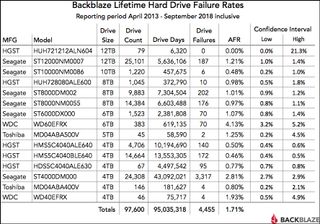

There is no info provided on how much was written to the drives nor do they separate drive failures for drives that failed at or over their endurance rating vs all other failures. Mind you, BackBlaze's charts are completely inadequate for SSD reporting. What we are seeing in the above chart is that the lower endurance drive drive is failing earlier, which makes sense given the difference in endurance. Compare that to the za250cm10003, which has an endurance rating of 150 TBW. Specifically looking at the za250cm10002, this drive has a 120 TBW endurance rating. Looking at the above chart, all the of SSDs with any failures are all 250 GB or below in capacity. This means that you can't make a valid comparison between different drive models based on SMART stats alone." The Self-Monitoring, Analysis, and Reporting Technology (SMART) attributes have been historically used to report and analyze HDD's general health, but SSD manufacturers are using those stats inconsistently and in a non-standardized way. "another (unpleasant) surprise coming from the latest Backblaze report is how useless SMART reporting can be when it comes to solid-state disks. as the old adage "cheap is as cheap does" would come into play IMHO.Īlso their statement about SMART data is interesting but not all that surprising: and also the statement about them using the cheapest drives they can buy w/ volume discounts is probably a factor too. Perhaps in a server environment, the added stress of continuous, 24/7/365 operation and such may present some additional issues, but in the consumer space, most of those would not really apply in most normal circumstances. This makes little sense, seeins how HDD's have so many moving parts that are so easily damaged and/or prone to failure, whereas SSD's are just electronic parts moving electrons around.


 0 kommentar(er)
0 kommentar(er)
